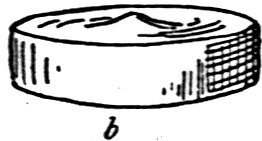Each source page number appears in brackets before the text of that page.
78. Mai-ka

[Page 237]Described by Brigham1 as a game played with the u-lu or o-lo-hu. The first name was current on Hawaii and Kauai, and the latter was known on Maui and Oahu. A smooth alley, or ka-hu-a, was required and three forms of the game were common. The first was a trial of strength, or throwing, or rather bowling, to the greatest distance; the second required more skill to drive the u-lu between two sticks near the end of the ka-hu-a; the third was rather a trial of the u-lu than of the players, as they were rolled against each other and the toughest won the game for its owner. There is a famous ka-hu-a near Kauai on Molokai, where may be seen hundreds of broken u-lu. The players trained carefully and developed great strength. Various kinds of stone were used, but a heavy compact coral rock was the favorite; the u-lu was sometimes spherical, but usually a thin cylinder with slightly convex ends (Plate XII, b).
The largest u-lu of the first form in the Bishop Museum has a diameter of 7 1/2 inches and weighs 22 pounds. Of the second and more common form the largest is 5 inches in diameter, 3 inches thick, and weighs 44 ounces. The smallest has a diameter of 1 7/8 inches and weighs 3 1/2 ounces. Rough and unfinished u-lu were used by children for practice. The average weight was a little over a pound. Choice ones were carefully oiled and kept in kapa. The u-lu exhibited in the Bishop Museum [Page 238]are made of lava, coral, breccia, conglomerate, limestone, and olivine, and there is one of wood.
Ellis2 says that the game of mai-ka is played upon the same floor as pa-hee. Two sticks are stuck in the ground only a few inches apart, at a distance of 30 or 40 yards, and between these, but without striking either, the parties at play strive to throw their stone. At other times the only contention is, who can bowl it farthest along the ka-hu-a, or floor. The people are, if possible, more fond of this game than of the pa-hee; and the inhabitants of a district not infrequently challenge the people of the whole island, or the natives of one island those of all the others, to bring a man who shall try his skill with some favorite player of their own district or island. On such occasions we have seen seven or eight thousand chiefs and people, men and women, assembled to witness the sport, which, as well as the pa-hee, is often continued for hours together.
Andrews gives ne-we-ne-we-we as "the exclamations of people when they play at mai-ka, while the stone is rolling and they cheer it on." Also hu-i-pa, i-ki-ma-ku-a, and ka-la-ma-u-la as names of species of stone out of which mai-ka are made. Andrews also states that since the introduction of bowling alleys u-lu-mai-ka has been applied to the game of bowls. My informants say the old game has disappeared, and that they apply the name to the game of bowls with pins.
Notes:
1. Preliminary Catalogue, part II, p. 56.
2. Vol. IV, p. 198.
Last update February 2, 2010